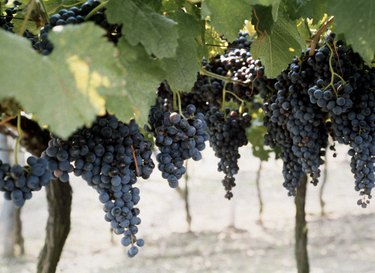
Growing grapes (Vitis spp.) isn't an exact science, and you can't predict exactly when you'll get to enjoy your harvest. Grapes of various varieties are grown throughout U.S. Department of Agriculture plant hardiness zones 2 through 10 where they are ready for harvest anywhere from mid- to late summer to early fall. The exact harvest time depends on the grape variety, the amount of sunlight the vine received and the specific growing conditions your grapes experience during the season. As a result, you may find yourself harvesting grapes at a slightly different time each year, even if you grow the same variety.
The Beginning
Video of the Day
Grape vines flower in early or mid-spring, at which time the plants become pollinated. Flowers typically appear in May, but this can vary by species. The pollinated blooms fall off the vine late in the spring season, leaving tiny grape berries behind. This process, known as shatter, occurs at the end of May or beginning of June. The tiny infant grapes spend the rest of the growing season developing and ripening. This process is a slow one that can take all summer and extend into the fall.
Video of the Day
Variety Variations
The best time to start checking your grapes for ripeness depends in part on the type of grapes you're growing. Cabernet Sauvignon grapes, for example, which grow in USDA zones 7 through 10, are a late variety that need a long growing season. You might be able to pick them as early as mid-September, but they might not ripen until the first two weeks of October. Chardonnay grapes, which also grow in USDA zones 7 through 10, are early grapes that typically ripen in mid-August. Other early grapes that are harvested from August through September include Pinot Noir (USDA zones 7-10) and Sauvignon Blanc (USDA zones 6-10). Mid-season grapes collected from September to October include Merlot (USDA zones 7-10) and Shiraz (USDA zones 6-10).
Native grapes, known as muscadines and scuppernongs (Vitis rotundifolia, zones 5-9), grow in loose clusters of large, thick-skinned fruits. Depending on the cultivar, the harvest window for these grapes is late summer to early fall.
Checking for Doneness
A grape's varietal status indicates the general time when it is harvest-ready, but it can't tell you exactly when your grapes will mature. Sun is a major factor in ripening grapes. If the summer was cloudier than normal, your grapes might ripen more slowly. All the grapes on a particular vine might not ripen on the same day -- bunches that sit on the shady side of the vine could take longer than those that get more sun. Grapes tend to develop color well before they're ready to pick, so color alone shouldn't dictate when you harvest. Squeezing the grapes gently helps you determine when they're ready. Mature grapes give slightly to your touch but will spring back when you release them. Grapes that are mushy have spent too much time on the vine while hard grapes aren't yet ready.
Tasting for Sweetness
One of the easiest ways to tell when your grapes are ready to pick is to taste them. Start tasting the grapes when they look like they are the right color and flex just a bit when squeezed. Continue tasting a grape daily or every other day until the grapes develop the sweet flavor you want. They don't continue to ripen after they're picked, so let them stay on the vine until the taste is right. For some varieties, this could mean tasting the grapes for several weeks, through September and into October.
- Old Farmer's Almanac: Grapes
- University of California Garden Web: Growing Grapes in Your Backyard
- Monrovia: Cabernet Sauvignon Grape
- Monrovia: Chardonnay Grape
- The Regents of the University of California: Annual Growth and Fruiting Cycle of a Grapevine
- Wine Folly: Start Planning Now for the Wine Harvest Season
- Grow Organic: Wine Grape Vine - Shiraz
- Grow Organic: Wine Grape Vine - Sauvignon Blanc
- Monrovia: Pinot Noir Grape
- Monrovia: Merlot Grape